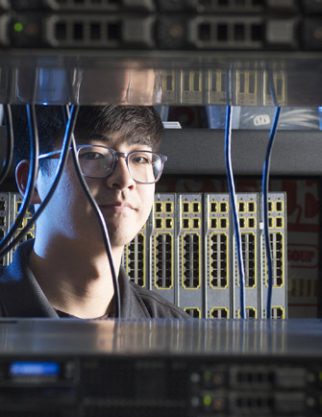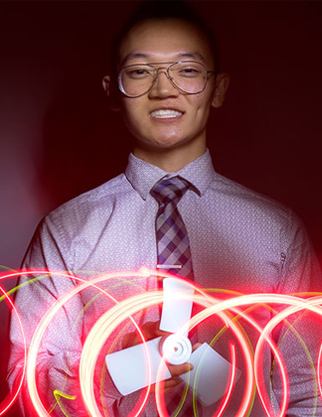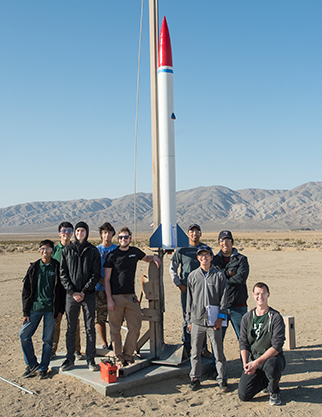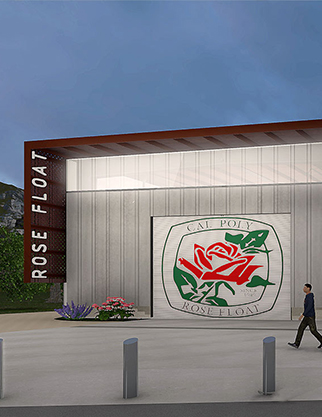Every couple of months or so, Architecture Professor Pablo La Roche journeys to Cerro Azul, a small community just south of the U.S. border near Tecate, Mexico.
The treks to work on the landscaping at the community center or to share his students’ ideas for shading options are not just about lending a hand.
La Roche, interim director of the Center for Regenerative Studies, is maintaining a connection to the project forged years prior by a collaboration between the university and Corazón, a non-governmental organization that focuses on helping families in need.
Cal Poly Pomona students in La Roche’s architectural design studio class designed the first version of the center in 2012, with input from Corazón and the community. The center, which opened in November 2016, provides skills training workshops for adults, daycare facilities, meeting spaces for the community and volunteer housing. Corazón does much of the work at the center. The opportunity for students to help with design and some construction has been invaluable, La Roche says.
“It’s something that has been very gratifying,” he says. “You’re teaching in many different ways. It’s our mission to educate, but we’re doing a lot more than just teaching architecture.”
Over the course of a year,students built and tested different low-cost sustainable systems for the center as rain water harvesting, low-cost solar hot water, a variable insulation-shading window; low-cost passive cooling systems such as roof ponds, radiators, cool towers; cooling with phase change materials; passive heating with direct gain, Trombe walls, and water wall systems; and even a rammed earth wall.
The evaporative cooling tower and the solar attic were further refined and incorporated in the final construction. In the summer, the pump-powerd tower cools the air to 69.5 degrees when it’s more than 98.5 outdoors. In the winter the solar attic on the roof heats the air, and a small fan pumps it down under the raised floor, warming the indoor space from below. Thermal mass in the attic stores heat to provide some nightime use.
“We expect to train the community in the construction of these systems so they can build on site providing them with a source of income while improving their conditions: true social, economic and environmental sustainability,” La Roche says.
The project has brought the students who participated in its design and the community together.
“Projects such as this one provide students with the opportunity to do good, while learning from practice,” he says.”
La Roche’s former students and a representative of Corazón share thoughts on their Cerro Azul experience.

Arianne Ponce (’15, architecture)
Although I was not part of the studio that conceived the initial design, I was fortunate to be part of a subsequent studio that tried to develop alternative low-cost sustainable systems to improve building performance and reduce environmental impact.
I see my experience with Corazón as an extension of Pablo’s studio into the real world. The sweat, the blisters on my hands and the exhaustion after returning from a long day of volunteering in Mexico are all indicators that learning doesn’t always occur inside an air-conditioned classroom.
This project is an excellent example of how a class and a dedicated professor not only can positively impact his students but also an entire community.
Barbara Gonzalez (’14, architecture; minor, Regenerative Studies)
As a student in Dr. La Roche’s studio, our class came up with individual ideas and then paired up with another who had a similar vision of what this community center should represent. As a studio we visited the community, spoke to members and became familiar with the Corazón team. I along with Hailey Peitzman (’14, architecture) felt that Corazón was about more than just creating a sense of togetherness but also about assisting in the development of self-sufficiency.
Over the summer of 2013, I worked with Dr. La Roche, HMC and Corazón Vice-President Terry Mackprang to further develop the center. The layout stayed the same, but the sustainable function definitely shaped the form. I believe we broke ground fall 2013 and it has been a journey since. Together with Corazón, volunteers and the community center members (most of whom are women), we have given the hills of Cerro Azul vibrancy.
You can definitely leave it up to Cal Poly Pomona to give their students the opportunity to have a real hands-on experience. I intend to stay a part of this organization and become more involved in my years to come.
Terry Mackprang, Corazón U.S. vice president
Corazón is an organization whose primary mission is to serve the poor in Northern Baja California by promoting self-sufficiency and responsibility. Put more simply, we believe that we help best when we intrude least.
Corazón’s affiliation with Cal Poly Pomona began over a decade ago when Professor Irma Ramirez and her students designed a series of innovative sign and information boards for our communities in Tijuana. As a member of the Corazón Board of Directors, Irma introduced us to Professor Pablo La Roche, believing that his work with sustainable architecture could mesh well with the Corazón program.
The vision has always been that this center be a living, full-scale laboratory to continue experiments in sustainable systems that could benefit the Corazón community. This carefully researched and optimally oriented cluster of five buildings will be the centerpiece of the rejuvenation and revival of the Cerro Azul community.
Jason D. Yeom, Lyle Center Postdoctoral Researcher
On Jan. 31, 2015, I was standing on the Cerro Azul community center site, looking at the half-finished community center building and thinking, “We’re going to need a lot of work on this.” That was my first trip to Cerro Azul, Tecate, and it was my very first trip to Mexico.
After the first trip, Pablo and I had regular meetings and continued developing the design while finalizing the construction details of the cool tower and solar attic, as well as a master plan for the whole site. Because our construction materials were very limited by the budget, it was a challenge to find a way to build a low-cost and effective cooling and heating system, and we also had to include some ideas from the local people in the design.
The Cerro Azul project has been a good opportunity for me to think about affordability of the passive systems and its practical application, and to collaborate with other experts, volunteers and local people. It was especially a great experience for me and other volunteers that we could witness a community participate and develop their own community center and learn about affordable sustainable design.
The full version of this story ran in the 2017 Winter/Spring issue of ENVirons Magazine.











